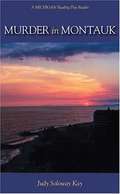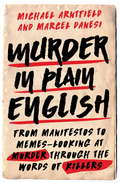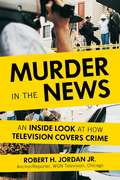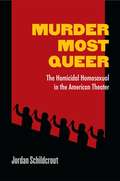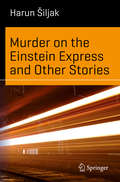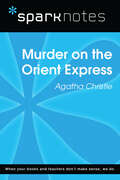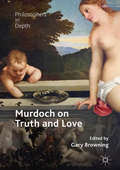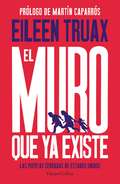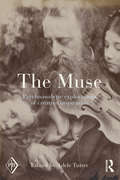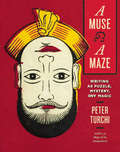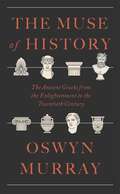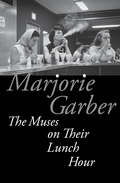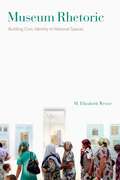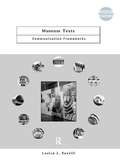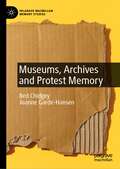- Table View
- List View
Murder in Montauk
by Judith KayCharlie Anderson, a reporter on leave from the Boston Globe, becomes entangled in an unusual mystery when he stumbles upon a news article about his own death. Confused and still very much alive, Charlie travels to Montauk, Long Island, to learn more about the deceased man and learns more about himself in the process. The MICHIGAN Reading Plus Readers are original fiction written for students who wish to improve their reading skills. The MICHIGAN Reading Plus Readers support the need for extensive reading on topics of interest to today's students. The Readers offer students books in the genres of mystery, science-fiction, and romance. Activities that practice vocabulary and reading skills are provided on the companion website.
Murder in Plain English: From Manifestos to Memes--Looking at Murder through the Words of Killers
by Marcel Danesi Michael ArntfieldThis is the first book to examine murder through the written word--not only the writings of the killers themselves, but also the story of murder as told in literary fiction and the crime dramas that are now a staple of film and television. The authors--a criminologist specializing in cold cases, written evidence, and forensic science, and an anthropologist who has dealt with the signs and ciphers of organized crime and street gangs in his previous work--are widely recognized experts in this emerging specialty field. Based on extensive research and interviews with convicted murderers, the book emphasizes the often-overlooked narrative impulse that drives killers, with the authors explaining how both mass and serial murderers perceive their crimes as stories and why a select few are compelled to commit these stories to writing whether before, during, or after their horrific acts. The book also analyzes the written work of killers, using a combination of machine-based linguistic patterning, predictive modeling, and symbolic interpretation, to make sense of the screeds of everyone from the Son of Sam and the Zodiac Killer to the Columbine attackers, the Unabomber, and the recent spate of mass shooters using social media as their preferred narrative platform. They present a theoretical perspective of murder that is based on both the criminological evidence and written works. In addition, the authors examine famous literature that has dealt ingeniously with murder and its relationship with real crime, from the Greek tragedians to Truman Capote to modern-day productions such as Making a Murderer. This unique approach offers a new means to penetrate the minds of murderers, revealing their motives as well as the wider social meanings of this age-old crime and our continuing fascination with it.From the Hardcover edition.
Murder in the News: An Inside Look at How Television Covers Crime
by Robert H. JordanA veteran, Emmy Award-winning TV news anchor provides a unique insider glimpse into the newsroom revealing how murder cases are selected for TV coverage.Television news anchor Robert Jordan Jr. draws from forty-seven years of news experiences to provide an eye-opening look at how news programs decide which murders to cover and which ones to ignore. Jordan takes readers behind the scenes into the big city newsrooms of Chicago. Here split-second decisions are made on where to send limited resources when dozens of shootings and several murders are occurring on a daily basis.Using interviews from decision makers--such as assignment editors and producers--who work daily in the trenches of working newsrooms, the reader learns how they decide where to send reporters; when to dispatch live trucks; and how the stories will be treated as they are placed in the news programming. Why will one story get "breaking news" banners and be placed at the top of the broadcast while others may not make the air at all or may be given casual mention in later segments?Additionally, Jordan reveals the results of a ground-breaking questionnaire sent to producers and assignment editors at Chicago television stations to assess their rationales for covering murder stories the way they do. Finally, he examines how the explosion of social media platforms has changed the dynamic of reporting the news and why murders are the perfect stories for television, as news organizations struggle to survive.
Murder Most Queer: The Homicidal Homosexual In The American Theater
by Jordan SchildcroutThe "villainous homosexual" has long stalked America's cultural imagination, most explicitly in the figure of the gay murderer, a character in dozens of plays. But as society's understanding of homosexuality has changed, so has the significance of these controversial characters, especially when employed by gay theater artists themselves to explore darker fears and desires. "Murder Most Queer" examines the shifting meanings of murderous gay characters in American theater over a century, showing how these representations wrestle with and ultimately subvert notions of gay villainy. "Murder Most Queer" works to expose the forces that create the homophobic paradigm that imagines sexual and gender nonconformity as dangerous and destructive and to show how theater artists--and for the most part gay theater artists--have rewritten and radically altered the significance of the homicidal homosexual. Jordan Schildcrout argues that these figures, far from being simple reiterations of a homophobic archetype, are complex and challenging characters who enact trenchant fantasies of empowerment, replacing the shame and stigma of the abject with the defiance and freedom of the outlaw, giving voice to rage and resistance. These bold characters also probe the darker anxieties and fears that can affect gay lives and relationships. Instead of sentencing them to the prison of negative representations, this book analyzes the meanings in their acts of murder, confronting the real fears and desires condensed in those dramatic acts.
Murder on the Einstein Express and Other Stories
by Harun ŠiljakThis collectionof stories touches upon many genres: Normed Trek is a clever and wittyAlice-in-Wonderland-type narrative set in the realm of mathematical analysis, The Cantor Trilogy is a dystopia about theconsequences of relying upon computer-based mathematical proofs, InSearch of Future Time bears the flavor of Tales from Arabian Nights set inthe future, and - last but not least - Murderon the Einstein Express is a short, non-technical primer on probabilitiesand modern classical physics, disguised as a detective story. Written primarily for an audience with some background or a stronginterest in mathematics, physics and computer science (in particular artificial intelligence), these stories explore theboundaries between science and fiction in a refreshingly unconventional fashion. In the Afterthoughts the author provides some further insights and annotations.
Murder on the Orient Express (SparkNotes Literature Guide Series)
by SparkNotesMurder on the Orient Express (SparkNotes Literature Guide) by Agatha Christie Making the reading experience fun! Created by Harvard students for students everywhere, SparkNotes is a new breed of study guide: smarter, better, faster. Geared to what today's students need to know, SparkNotes provides: *Chapter-by-chapter analysis *Explanations of key themes, motifs, and symbols *A review quiz and essay topicsLively and accessible, these guides are perfect for late-night studying and writing papers
Murder Trials
by CiceroCicero's speeches "In Defence of Sextus Roscius of Amerina," "In Defence of Aulus Cluentius Habitus," "In Defence of Gaius Rabirius," "Note on the Speeches in Defence of Caelius and Milo," and "In Defence of King Deiotarus" provide insight into Roman life, law, and history.
Murder Your Darlings: And Other Gentle Writing Advice from Aristotle to Zinsser
by Roy Peter ClarkFrom one of America's most influential teachers, a collection of the best writing advice distilled from fifty language books -- from Aristotle to Strunk and White.With so many excellent writing guides lining bookstore shelves, it can be hard to know where to look for the best advice. Should you go with Natalie Goldberg or Anne Lamott? Maybe William Zinsser or Stephen King would be more appropriate. Then again, what about the classics -- Strunk and White, or even Aristotle himself?Thankfully, your search is over. In Murder Your Darlings, Roy Peter Clark, who has been a beloved and revered writing teacher to children and Pulitzer Prize winners alike for more than thirty years, has compiled a remarkable collection of more than 100 of the best writing tips from fifty of the best writing books of all time. With a chapter devoted to each key strategy, Clark expands and contextualizes the original author's suggestions and offers anecdotes about how each one helped him or other writers sharpen their skills. An invaluable resource for writers of all kinds, Murder Your Darlings is an inspiring and edifying ode to the craft of writing.
Murdoch on Truth and Love (Philosophers in Depth)
by Gary BrowningThis book reviews Iris Murdoch’s thought as a whole. It surveys the breadth of her thinking, taking account of her philosophical works, her novels and her letters. It shows how she explored many aspects of experience and brought together apparently contradictory concepts such as truth and love. The volume deals with her notions of truth, love, language, morality, politics and her life. It shows how she offers a challenging provocative way of seeing things which is related to but distinct from standard forms of analytical philosophy and Continental thought. Unlike so many philosophers she does offer a philosophy to live by and unlike many novelists she has reflected deeply on the kind of novels she aimed to write. The upshot is that her novels and her philosophy can be read together productively as contributions to how we can see others and the world.
Murnane
by Emmett StinsonGerald Murnane is one of Australia's most celebrated authors whose experimental and deeply idiosyncratic style has attracted rave reviews, including profiles in The New Yorker and The New York Times. Murnane's writing combines fiction with autobiography and returns obsessively to his particular and uncommon interests: horse-racing, marbles, stained glass, Catholic iconography, hermetic writers, and the Australian landscape. His fiction offers a window into what it means to be human, and how books and reading shape our self-understanding. Murnane examines the writer's recent work to explain both its significance to Australian literature and provide readers with a deeper understanding of his complex and self-referential fiction.
El muro que ya existe
by Eileen TruaxDurante décadas ha operado una máquina anti inmigratoria del gobierno estadounidense en connivencia con el mexicano, cometiendo violaciones a los derechos humanos e incumpliendo los estatutos internacionales para brindar refugio. En un país que empezó teniendo perseguidos políticos desde el salinismo, hasta el masivo desplazamiento forzada a causa de las políticas de seguridad del calderonismo, Eileen Truax, expone a través de un reporteo altamente contextualizado, las historias de quienes huyen de manera desesperada y sin encontrar el cobijo legal, económico y social de su país de origen, ni en el que históricamente se ha comprometido ante el mundo.
The Muse: Psychoanalytic Explorations of Creative Inspiration (Psychoanalytic Inquiry Book Series)
by Adele TutterPsychoanalysts have long been fascinated with creative artists, but have paid far less attention to the men and women who motivate, stimulate, and captivate them. The Muse counters this trend with nine original contributions from distinguished psychoanalysts, art historians, and literary scholars—one for each of the nine muses of classical mythology—that explore the muses of disparate artists, from Nicholas Poussin to Alison Bechdel. The Muse breaks new ground, pushing the traditional conceptualization of muses by considering the roles of spouse, friend, rival, patron, therapist—even a late psychoanalytic theorist—in facilitating creativity. Moreover, they do so not only by providing inspiration, but also by offering the artist needed material and emotional support; tolerating competitive aggression; promoting reflection and insight; and eliciting awe, anxiety and gratitude. Integrating art history and literary criticism with a wide spectrum of contemporary psychoanalytic perspectives, The Muse is essential reading for psychoanalysts and psychotherapists interested in the relationships that enhance and support creative work. Fully interdisciplinary, it is also accessible to readers in the fields of art, art history, literature, memoir, and film. The Muse sheds new light on that most mysterious dyad, the artist and muse—and thus on the creative process itself.
A Muse and a Maze
by Peter TurchiWith his characteristic genius for finding connections between writing and the stuff of our lives, Peter Turchi ventures into new and even more surprising territory. In A Muse and a Maze, Turchi draws out the similarities between writing and puzzle-making and its flip-side, puzzle-solving. As he teases out how mystery lies at the heart of all storytelling, he uncovers the magic-the creation of credible illusion-that writers share with the likes of Houdini and master magicians. In Turchi's associative narrative, we learn about the history of puzzles, their obsessive quality, and that Benjamin Franklin was a devotee of an ancient precursor of sudoku called Magic Squares. Applying this rich backdrop to the requirements of writing, Turchi reveals as much about the human psyche as he does about the literary imagination and the creative process.
Muse of Fire: World War I as Seen Through the Lives of the Soldier Poets
by Michael KordaThe First World War comes to harrowing life through the intertwined lives of the soldier poets in Michael Korda’s epic Muse of Fire. Michael Korda, the best-selling author of Hero and Alone, tells the story of the First World War not in any conventional way but through the intertwined lives of the soldier poets who came to describe it best, and indeed to symbolize the war’s tragic arc and lethal fury. His epic narrative begins with Rupert Brooke, “the handsomest young man in England” and perhaps its most famous young poet in the halcyon days of the Edwardian Age, and ends five years later with Wilfred Owen, killed in action at twenty-five, only one week before the armistice. With bitter irony, Owen’s mother received the telegram informing her of his death on November 11, just as church bells tolled to celebrate the war’s end. Korda’s dramatic account, which includes anecdotes from his own family history, not only brings to life the soldier poets but paints an unforgettable picture of life and death in the trenches, and the sacrifice of an entire generation. His cast of characters includes the young American poet Alan Seeger, who was killed in action as a private in the French Foreign Legion; Isaac Rosenberg, whose parents had fled czarist anti-Semitic persecution and who was killed in action at the age of twenty-eight before his fame as a poet and a painter was recognized; Robert Graves and Siegfried Sassoon, whose friendship and friendly rivalry endured through long, complicated private lives; and, finally, Owen, whose fame came only posthumously and whose poetry remains some of the most savage and heartbreaking to emerge from the cataclysmic war. As Korda demonstrates, the poets of the First World War were soldiers, heroes, martyrs, victims, their lives and loves endlessly fascinating—that of Rupert Brooke alone reads like a novel, with his journey to Polynesia in pursuit of a life like Gauguin’s and some of his finest poetry written only a year before his tragic death. Muse of Fire is at once a portrait of their lives and a narrative of a civilization destroying itself, among the rubble, shadows, and the unresolved problems of which we still live, from the revival of brutal trench warfare in Ukraine and in the Middle East.
The Muse of History: The Ancient Greeks from the Enlightenment to the Present
by Oswyn MurrayHow the modern world understood the ancient Greeks and why they matter today.“This majestic book by Oswyn Murray has been long and eagerly awaited…and its quality and scope exceed expectations.” —Edith Hall, BBC History MagazineThe study of ancient Greece has been central to Western conceptions of history since the Renaissance. The Muse of History traces the shifting patterns of this preoccupation in the last three centuries, in which successive generations have reinterpreted the Greeks in the light of their contemporary worlds. Thus, in the eighteenth century, the conflict between Athens and Sparta became a touchstone in the development of republicanism, and in the nineteenth, Athens came to represent the democratic ideal. Amid the ideological conflicts of the twentieth century, the Greeks were imagined in an age of suffering, inspiring defenses against nationalism, Nazism, communism, and capitalism.Oswyn Murray draws powerful conclusions from this historiography, using the ever-changing narrative of ancient Greece to illuminate grand theories of human society. Analyzing the influence of historians and philosophers including Hegel, Burckhardt, Nietzsche, and Braudel, Murray also considers how coming generations might perceive the Greeks. Along the way, The Muse of History offers rare behind-the-scenes glimpses of figures who shaped the study of ancient Greece, some devotedly cited to this day and others forgotten. We sit in on a class with Arnaldo Momigliano; meet Moses Finley after his arrival in England; eavesdrop on Paul Veyne, Jean-Pierre Vernant, and Pierre Vidal-Naquet; and rediscover Michel Foucault.A thrilling work that rewrites established scholarly traditions and locates important ideas in unexpected places, The Muse of History reminds us that the meaning of the past is always made in and for the present.
The Muses Among Us: Eloquent Listening And Other Pleasures Of The Writer's Craft
by Kim StaffordThe Muses Among Us is an inviting, encouraging book for writers at any stage of their development. In a series of first-person letters, essays, manifestos, and notes to the reader, Kim Stafford shows what might happen at the creative boundary he calls "what we almost know." On the boundary's far side is our story, our poem, our song. On this side are the resonant hunches, griefs, secrets, and confusions from which our writing will emerge. Guiding us from such glimmerings through to a finished piece are a wealth of experiments, assignments, and tricks of the trade that Stafford has perfected over thirty years of classes, workshops, and other gatherings of writers. <P><P> Informing The Muses Among Us are Stafford's own convictions about writing--principles to which he returns again and again. We must, Stafford says, honor the fragments, utterances, and half-discovered truths voiced around us, for their speakers are the prophets to whom writers are scribes. Such filaments of wisdom, either by themselves or alloyed with others, give rise to our poems, stories, and essays. In addition, as Stafford writes, "all pleasure in writing begins with a sense of abundance--rich knowledge and boundless curiosity." By recommending ways for students to seek beyond the self for material, Stafford demystifies the process of writing and claims for it a Whitmanesque quality of participation and community.
The Muses on Their Lunch Hour
by Marjorie Garber&“Witty, shrewd, and imaginative essays on interdisciplinary topics . . . from Shakespeare to psychoanalysis, and the practice of higher education today.&” —Publishers Weekly As a break from their ordained labors, what might the Muses do on their lunch hour today? This collection of essays uses these figures of ancient legend to explore such modern-day topics as the curious return of myth and ritual in the theories of evolutionary psychologists and much more. Two themes emerge consistently. The first is that to predict the &“next big thing&” in literary studies, we should look back at ideas and practices set aside by a previous generation of critics. In the past several decades we have seen the reemergence of—for example—textual editing, biography, character criticism, aesthetics, and philology as &“hot&” new areas for critical intervention. The second theme expands on this observation, making the case for &“cultural forgetting&” as the way the arts and humanities renew themselves, both within fields and across them. Although she is never represented in traditional paintings or poetry, a missing Muse—we can call her Amnesia—turns out to be a key figure for the creation of theory and criticism in the arts.
Museum Mediations: Reframing Ekphrasis in Contemporary American Poetry (Literary Criticism and Cultural Theory)
by Barbara K. FisherFirst published in 2006. Routledge is an imprint of Taylor & Francis, an informa company.
Museum Rhetoric: Building Civic Identity in National Spaces (RSA Series in Transdisciplinary Rhetoric #5)
by George Sand Gretchen Van SlykeSet in the French countryside of George Sand’s childhood and narrated in the unique voice of a Berrichon peasant, La Petite Fadette is a beloved 1848 novel about identical twin brothers and Fadette, the mysterious waif with whom they both fall in love. The brothers, Landry and Sylvinet, belong to a highly respected farm family. When young Landry meets Fadette, whose very name suggests that she is a witch, he is captivated by the girl despite her lowly status and disreputable family. Sylvinet soon follows suit. Fadette’s relationship with the twins defies the patriarchal norms of French society as well as the expectations of the village, resulting in a tale of love, courage, and clever strategy winning out over superstition and prejudice.Often regarded as a simple country tale, Sand’s novel is layered with meaning, including subtle nods to the burgeoning desire for political and sexual equality in nineteenth-century France. This thoughtful critical translation by Gretchen van Slyke brings the complexity of the original story to life. Her introduction explores the autobiographical and political dimensions of the novel, and her translation preserves the rustic charm and archaic flavor of Sand’s language.An invaluable contribution to French literary studies and nineteenth-century literature studies, this new edition ensures that La Petite Fadette will be read by generations to come.
Museum Rhetoric: Building Civic Identity in National Spaces (RSA Series in Transdisciplinary Rhetoric #5)
by M. Elizabeth WeiserIn today’s diverse societies, museums are the primary institutions within the public sphere in which individuals can both engage critical thought and celebrate community. This volume uses the lens of rhetoric to explore the role these societal repositories play in establishing and altering cultural heritage and national identity.Based on fieldwork conducted in over sixty museums in twenty-two countries across six continents, Museum Rhetoric explores how heritage museum exhibits persuade visitors to unite their own sense of identity with that of the broader civic society and how the latter changes in response. Elizabeth Weiser explores what compels communities, organizations, and nations to create museum spaces, and how museums operate as sites of both civic engagement and rhetorical persuasion. Moving beyond rhetorical explorations of museums as “memory sites,” she shows how they intentionally straddle the divides between style and content, intellect and affect, unity and diversity, and why their portrayal of the past matters to civic life—and particularly studies of nationalism—in the present and future.Deeply researched and artfully argued, Museum Rhetoric sheds light on the public impact of cultural and aesthetic heritage and opens avenues of inquiry for scholars of museum studies and public history.
Museum Texts: Comunication Frameworks (Museum Meanings)
by Louise RavelliAnswering key questions in the study of how museums communicate, Louise Ravelli provides a set of frameworks to investigate the complexities of communication in museums: * What is an appropriate level of complexity for a written label?* Why do some choice in language make a more direct relation to visitors?* Is there a correct way of presenting a particular view of content?* How do design practices contribute to the overall meanings being made? The frameworks enhance the way we critically analyze and understand museums text, both in the sense of conventional – written texts in museums – and in an expanded sense of the museum as a whole operating as a communicative text. Using a wide range of examples Ravelli argues that communication contributes fundamentally to what a museum is, who it relates to and what it stands for. Not only museum studies and communications studies students, but also professionals in the field will find Museum Texts an indispensable guide on communication frameworks.
Museum Trouble
by Ruth HobermanBy 1901, the public museum was firmly established as an important national institution in British life. Its very centrality led to its involvement in a wide range of debates about art, knowledge, national identity, and individual agency. Ruth Hoberman argues that these debates concerned writers as well. Museum Trouble focuses on fiction written between 1890 and 1914 and the ways in which it engaged the issues dramatized by and within the museum.Those issues were many. Art critics argued about what kind of art to buy on behalf of the nation, how to display it, and whether salaried professionals or aristocratic amateurs should be in charge. Museum administrators argued about the best way to exhibit scientific and cultural artifacts to educate the masses while serving the needs of researchers. And novelists had their own concerns about an increasingly commercialized literary marketplace, the nature of aesthetic response, the impact of evolution and scientific materialism, and the relation of the individual to Britain's national and imperial identity.In placing the many crucial museum scenes of Edwardian fiction in the context of late nineteenth-century and early twentieth-century cultural discourse, Museum Trouble shows how this turn-of-the-century literature anticipated many of the concerns of the modernist writers who followed.
Museums, Archives and Protest Memory (Palgrave Macmillan Memory Studies)
by Red Chidgey Joanne Garde-HansenThis book addresses the emergence of ‘protest memory’ as a powerful contemporary shaper of ideas and practices in culture, media and heritage domains. Directly focused on the role of museum and archive practitioners in protest memory curation, it makes a compelling contribution to our understanding of how social movements and activist experiences are publicly remembered and activated for social and environmental justice.
Museums as Sites of Transformative Foreign Language Learning Beyond the Classroom (New Language Learning and Teaching Environments)
by Fabiana FazziThis book takes a look at the affordances of engaging second/foreign language students in educational projects that bridge the gap between the classroom and the museum. Studies on language learning and teaching beyond the classroom have shown that students learn in different settings and through different types of activities and that their learning is influenced by the intersection of different dimensions. Drawing on both language and museum learning and teaching research, this book discusses the aspects that make the museum an ideal language learning setting and then outlines evidence-based pedagogical guidelines to design effective learning experiences for language learners across the classroom and the museum. It will be of interest to graduate students, language teachers, teacher trainers, museum educators, and researchers in fields including Educational Linguistics, Anthropological Linguistics, and Museum Studies (Education).
Museums of Language and the Display of Intangible Cultural Heritage (Routledge Research in Museum Studies)
by Margaret J.-M. Sönmez Maia Wellington Gahtan Nadia CannataMuseums of Language and the Display of Intangible Cultural Heritage presents essays by practitioners based in language museums around the world. Describing their history, mission, and modes of display, contributors demonstrate the important role intangible heritage can and should play in the museum. Arguing that languages are among our most precious forms of cultural heritage, the book also demonstrates that they are at risk of neglect, and of endangerment from globalisation and linguistic imperialism. Including case studies from across Europe, North America, Africa, and Asia, this book documents the vital work being done by museums to help preserve languages and make them objects of broad public interest. Divided into three sections, contributions to the book focus on one of three types of museums: museums of individual languages, museums of language groups – both geographic and structural – and museums of writing. The volume presents practical information alongside theoretical discussions and state-of-the-art commentaries concerning the representation of languages and their cultural nature. Museums of Language and the Display of Intangible Cultural Heritage is the first volume to address the subject of language museums and, as such, should be of interest to academics, researchers, and postgraduate students in the fields of museum and cultural heritage studies, applied linguistics, anthropology, tourism, and public education.
